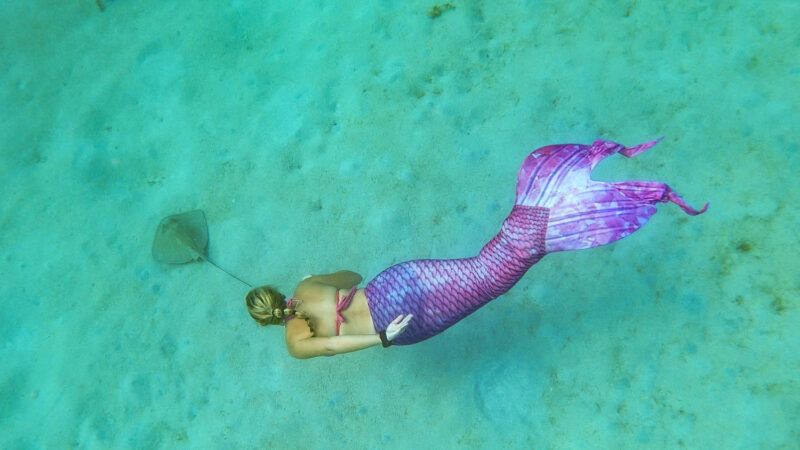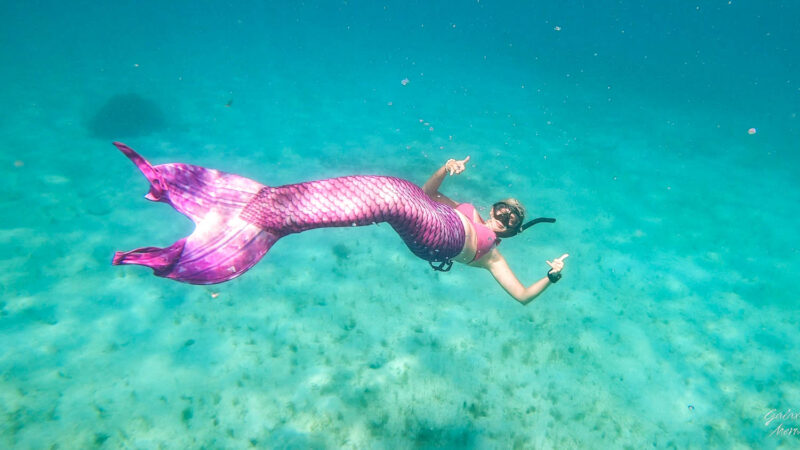
Seasterhood
So, you want to be a mermaid?
Donning a fin and taking to the water is a growing, global, $500-million-dollar industry.
Morgan Leet, a newly-minted chef from New Hampshire, came to St. Croix for a fresh start. She got a job cooking on one of the resorts dotting the island. But one day she stopped into a local dive shop—and she heard the siren call. What happened next was fin-tastic.
Today Leet, 24, is a mermaid. Specifically, she is a certified professional diving instructor in both scuba and free-diving. But she also went for her mermaid certification because, increasingly around the island—and around the world—there was a demand to introduce both adults and kids to the slinky aquatic art.

A mermaid? Well, yes. These days, it seems, anywhere you find a body of water, you will find mermaid classes, conventions, and contests. And this is not just a fascination coming from little girls raised on the romantic Disney Little Mermaid franchise. According to the just-released Netflix special, Merpeople—a four-part documentary on folks devoted to the lifestyle—mermaiding (it’s a verb now) is a growing, and global, half-billion-dollar industry.
“Mermaiding sounds super fun—and it is—but it is still holding your breath and free-diving,” Leet says. “So there’s a little bit of danger, and you need to know what you’re doing.” One of the first skills everyone learns, she explains, is the “tail bail,” learning how to get out of your monofin quickly.
But after safety training you learn somersaults, bubbling, mermaid handshakes—and seasterhood (mermaids are very, very into puns). Getting an advanced certification in mermaiding takes an extra four or five hours of training, and takes you out of pools and into quarries, oceans and lakes. To the truly dedicated, this isn’t just about performance. It’s a way of life. Think: cosplay under water.
Our fascination with mermaids long preceded that moment the exquisite Daryl Hannah washed up on shore in the 1984 movie Splash. Half women/half fish have figured in folklore throughout the world—sometimes imparting wisdom, and sometimes luring men to their death.


For the past 40 years, New Yorkers have celebrated freedom, self-expression, and sparkly-tailed glam with The Mermaid Parade in Coney Island. In a nod to the black Ariel in the new, live-action Little Mermaid, this year’s Queen Mermaid and King Neptune were Laurie Cumbo, New York City’s Commissioner of Cultural Affairs, and hip-hop recording artist Kool Keith. (You know the event is pure NYC when you look at the list of prior parade Kings and Queens and note that a few years back it was Lou Reed and Laurie Anderson.)
Now there are entire organizations dedicated to the mermaid craze; at aquamermaid.com, for example, you can take classes in cities across the country, you can hire mermaids (and mermen) to hang out at your party, you can go on mermaid vacations—and you can buy your own tail.
Kids’ fabric tails cost around $100, while a professional adult custom silicone tail and top can set you back around $1,700. (Sounds like a lot, but what price to look like the world’s most dazzling goldfish?)


Jen Downey has top PADI (Professional Association of Diving Instructors) certification, and teaches mermaiding in locales as varied as the Virgin Islands and Washington, DC; she also runs Sirens and Sunsets, a retreat at various paradises (St. Croix, Cozumel) for mermaids and the people who love them: just pack your bag and your fin and Downey organizes all the mercoaching, kayaking, fire dancing, and rumsails a merperson could want.
Is there an Instagram-aesthetic to the whole movement? Sure. Mermaiding is a fantastic core workout (go ahead, try swimming by undulating the entire lower half of your body), and involves more than a little theater.
It’s definitely a performance,” Leet says, “from a physical point of view—to do a breath hold and tricks and have your eyes open in salt water and pretend it’s not painful . . . but, you know, women are good at prioritizing beauty over pain.”
But what Downey—nom de Mermaid, Galaxsea (did we mention puns?)—wants people to understand is that the lifestyle is not only for the young and perfect. “Mermaids are a loving and inclusive community,” Downey, 42, says. “It doesn’t matter what the media tells you: anybody can be a mermaid. I just certified a woman in her sixties,” she added, when I asked if there was still hope for me.
There is a group called Mermaid at Any Age. There is also one called The Society of Fat Mermaids. And, of course, there is many a Merman (none going by the name “Ethel,” as far as I can tell) and they are not all the equivalent of Chippendales Dancers of the Sea. (Average mermaid salary? $67.31 an hour, according to Zip Recruiter.)
People devoted to mermaiding would argue they are not so much sacrificing their voice for love, as in the traditional Hans Christian Anderson story; in fact, they are about giving voice to love—specifically, love of the water and its creatures. “Of course, this is about fun and sometimes performance,” notes Downey. But it’s also about education.” There are mermaids who work at aquariums and instruct viewers about sea life. Like Mermaid Echo . . . she is one of the pioneers in the industry, and works at a freshwater aquarium in Wisconsin teaching people about different fish species.
“The most important thing is getting people to love being in the water, and mermaiding is really about a loving connection between humans and the sea,” Downey continues. “Because the more you love something, the more you want to protect it.”
Hero photo: courtesy of GalaxSea



